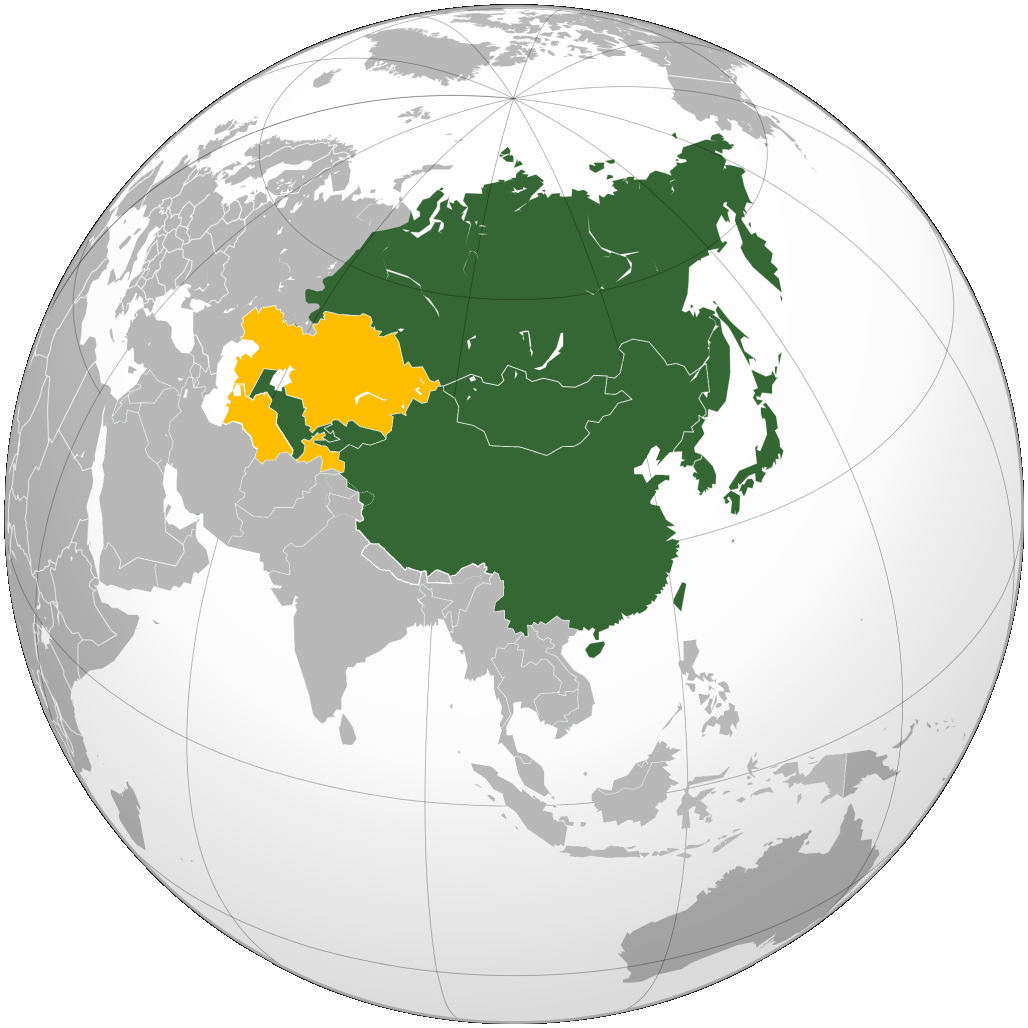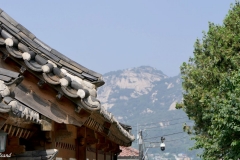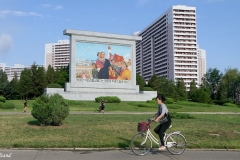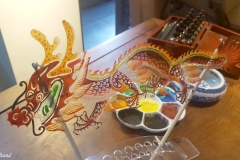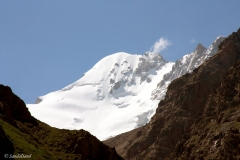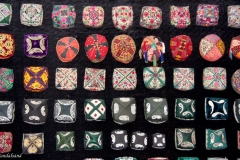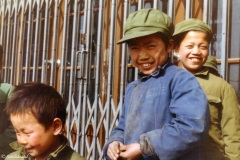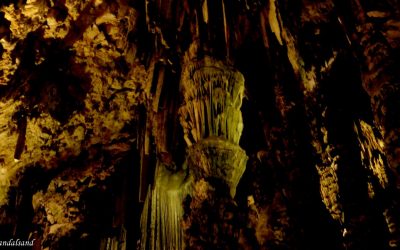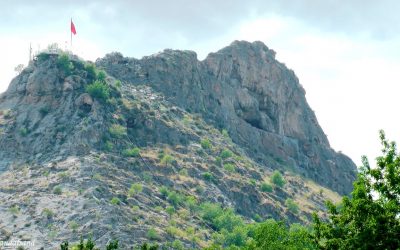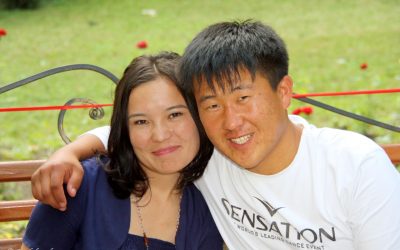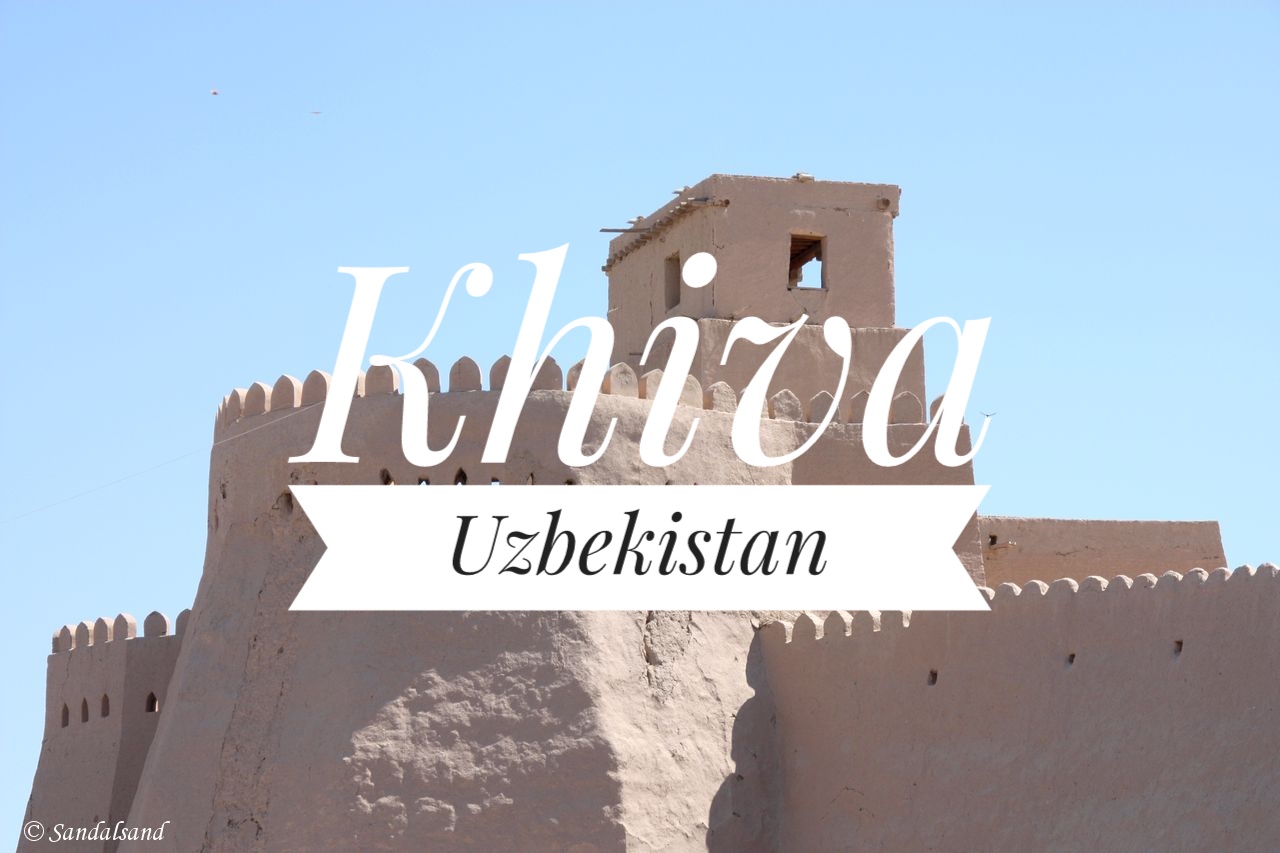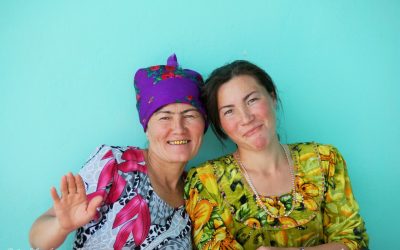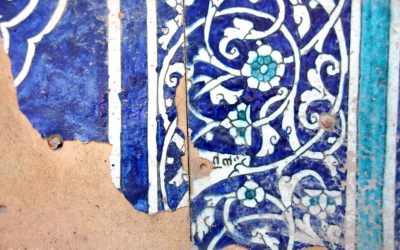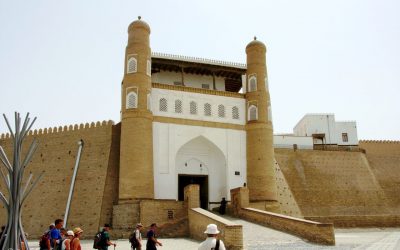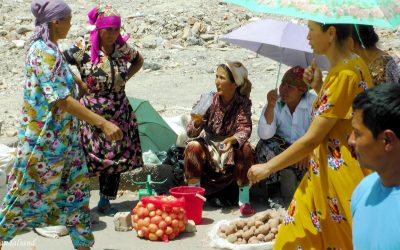Intro
Countries
Photos
Blog
Facts
Overall impressions
These women emerged from their houses at the Sera monastery in Tibet in 1985. They brushed their hair and aprons and asked us to take their pictures, so we did.
However, they were disappointed to learn that we didn’t have Polaroid cameras with instant processing and printing. They must have encountered or heard about tourists with such cameras before. No “travellers” had them, as I wrote about this scene many years ago.
In fact, this situation does not seem typical of East Asia in my opinion. People there are generally very up-to-date with technology. My impressions of this part of the world are certainly characterized by human curiosity and friendliness, combined with a traditional sense of hospitality. This holds true not only in remote places like Tibet and Mongolia but also in modern-day Japan.
An even stronger impression is the hectic way of life most East Asians lead. This is partly due to living in one of the world’s most densely populated regions, but I also believe there are cultural reasons for this.
To counteract this, it’s no surprise that the region has developed religious philosophies emphasizing deep meditation and mental balance. Today, East Asian society faces many challenging balancing acts: old and new; traditional and modern; work and leisure; manual and mental; stagnation and growth; poverty and prosperity; collectivism and individualism.
Countries
China | Japan | Kazakhstan | Kyrgyzstan | Mongolia | North Korea | Russia | South Korea | Taiwan | Tajikistan | Turkmenistan | Uzbekistan
There are three different regions under this heading. North Asia is by Wikipedia defined as Russia east of the Ural Mountains. East Asia is a larger region of six countries. Central Asia consists of five stan-countries.
Sandalsand has been to nine independent countries out of 12. The links above open lists with all articles from that particular country.
Taiwan’s status is a problem, in more than one way. I include it in this list for practical purposes.
Photo galleries
Open the box to view a multitude of picture galleries from Sandalsand’s travels in this region.
Click to show or hide
Open the box to view picture galleries from my travels in this region. I would recommend you to open a picture gallery in a new tab or window.
Distance tests a horse’s strength. Time reveals a person’s character.” (Chinese proverb)
Posts from North, Central and East Asia
Nature: 8 Dramatic Cliffs
Here you will find 8 dramatic cliffs. Steep mountain slopes hitting the waves on a coastline are always dramatic, especially in rough weather....
Nature: 7 Strange Rock Formations
What do I mean by 7 strange rock formations? Well, the Earth’s surface is full of loose stones and boulders and solid rocks. Some have over the...
Nature: 10 Great Caves
A cave is a hollow place in the ground, often very deep but also quite small like a grotto. Here is a nice selection av 10 great caves. This...
World Heritage #1230 – Sulaiman-Too Sacred Mountain
Come to the Sulaiman-Too Sacred Mountain to pray like they have been doing in Central Asia for centuries. The UNESCO World Heritage List includes...
VIDEO – Faces of Central Asia
This video with faces of Central Asia is a collection of primarily portrait photographs of people from the Central Asian republics of Uzbekistan and...
VIDEO – Kyrgyzstan – Osh to Bishkek
This video is from a drive from Osh and Bishkek, two low-lying towns in Kyrgyzstan. To get from one to the other involves driving through narrow as...
VIDEO – Uzbekistan – Khiva
This is a video from Khiva. The ancient city on the Silk Road is still alive, welcoming anyone who has crossed the desert to get here. This...
Pictures from Kyrgyzstan
This is a collection of pictures from Kyrgyzstan, the result of a trip in 2014 around the country and the capital. If you look up my articles from...
Bishkek and the valley of Ala Archa
Even a poor country has its proud monuments, and being the capital of Kyrgyzstan, Bishkek has a fair number of them. In addition, there is mighty...
Nomadic life on the mountain passes of Kyrgyzstan
Driving over the string of mountain passes of Kyrgyzstan from the fertile Fergana valley in the south we emerged on the plains in the north after a...
Pictures from Uzbekistan
This is a collection of pictures from Uzbekistan, the result of a trip in 2014 around the country to ancient cities on the Silk Road. If you look up...
The fertile Fergana Valley
The Fergana valley is one of the world's most fertile valleys and always has been. In addition Stalin drew a map making it one of the most complex...
The magnificent oasis of Khiva
Squeezed in between the Kyzylkum and Karakum deserts we find Khiva, or Itchan Kala as it was known when slaves were traded and silk passed by on...
World Heritage #0543 – Itchan Kala
Let us us all go back to the old caravan routes of the Silk Roads, and to Itchan Kala in the oasis of Khiva. The UNESCO World Heritage List includes...
The Emir of Bukhara and the lost camels
The man on the image from 1911 was the last Emir of Bukhara. Join me for a look into days long lost, and read what happened to him and his...
World Heritage #0602 – Bukhara
The madrassas and mosques in the Historic Centre of Bukhara are impressive. They provide a sense of what the days of the Silk Road were like. The...
World Heritage #0885 – Shakhrisyabz
The Historic Centre of Shakhrisyabz is the birthplace of the Great Tamerlane, the king and conqueror of a vast empire in Central Asia in the 14th...
Shakhrisabz and the birth of a nation
A nation was born in Shakhrisabz. This is rule number 1 in nation building: Go back in history and find an epic figure, mythical or real, and gather...
World Heritage #0603 – Samarkand
Samarkand was at the centre of the famous Silk Road. It passed through present-day Uzbekistan and was of vital importance to the trade between east...
The road to Samarkand
Three of history's greatest warlords found reason to conquer and ravage the city of Samarkand. Time and again the city rose from the ashes to regain...
The monumentalism of Tashkent
Being the capital of Uzbekistan and the largest city in Central Asia, Tashkent has every reason to show off, and it does. This is clearly evident in...
VIDEO – Uzbekistan – Tashkent
Tashkent, the capital of Uzbekistan, is the largest city of Central Asia. This video brings you the sights of Old Tashkent, as well as squares and...
In search of the ancient Silk Road
This is about a trip on the Silk Road in the Central Asian republics of Uzbekistan and Kyrgyzstan. Marco Polo was here before me. The article is...
Defensive Structures (1) The huge ones
There are some historically significant and physically huge defensive structures around the world. They built them to protect entire countries...
When you have completed 95 percent of your journey, you are only halfway there. (Japanese proverb)
A fact sheet
North Asia

- Region: North Asia
- States and territories: Russia
- Population (2017): 33,765,005
Geography
North Asia or Northern Asia, sometimes known as Siberia, is a subregion of Asia, consisting of the Russian regions of Siberia, Ural and the Russian Far East – an area east of the Ural Mountains. The region is sometimes also referred to as Asian Russia. The total population of North Asia is about 33 million. North Asia makes up more than 75% of the territory of Russia, but only 22% of its population, at a density of 2.5 people per km2.
Demography
There are around 38 million Russians living east of the Ural Mountains, the informal divide between Europe and Asia. Native Siberians are a minority in Siberia/North Asia due to the Russification process during the last three centuries.
The Buryats numbering 445,175 is the largest ethnic minority group in Siberia. There are 443,852 Yakuts (Russian Census of 2002) living in Siberia. According to the 2002 census there are 500,000 Tatars in Siberia, but 300,000 of them are Volga Tatars who settled in Siberia during periods of colonisation. Other ethnic groups that live in the region and make a significant portion are ethnic Germans and they number about 400,000.
Source: Wikipedia.
East Asia
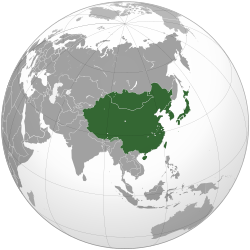
- Region: East Asia
- Area: 11,839,074 km2
- Population (2016): 1,641,908,531
- Density: 140/km2
- States: China, Japan, Mongolia, North Korea, South Korea, Taiwan
Geography
East Asia is the eastern subregion of the Asian continent, which can be defined in either geographical or ethno-cultural terms. Geographically and geopolitically, the region constitutes Greater China (Greater China consists of Chinese mainland, Hong Kong, Macau and Taiwan), Japan, Mongolia, North Korea and South Korea.
Religion
The region was the cradle of various ancient civilizations such as Ancient China, ancient Japan, ancient Korea, and the Mongol Empire. Major religions in East Asia include Buddhism (mostly Mahayana), Confucianism and Neo-Confucianism, Taoism, Ancestral worship, and Chinese folk religion in Mainland China, Hong Kong, Macau and Taiwan, Buddhism and Shintoism in Japan, and Christianity, Buddhism and Sindoism in Korea. Shamanism is also prevalent among Mongols and other indigenous populations of northern East Asia such as the Manchus.
Demography
At the present time East Asians comprise around 1.6 billion people, making up about 38% of the population in Continental Asia and 22% of the global population. The region is home to major world metropolises such as Beijing, Hong Kong, Seoul, Shanghai, Taipei, and Tokyo. Although the coastal and riparian areas of the region form one of the world’s most populated places, the population in Mongolia and Western China, both landlocked areas, is very sparsely distributed, with Mongolia having the lowest population density of a sovereign state. The overall population density of the region is 133 inhabitants per square kilometre, about three times the world average of 45/km2
Source: Wikipedia.
Central Asia
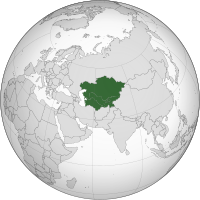
- Region: Central Asia
- Area: 4,003,451 km2
- Population: 69,787,760
- Pop. density: 17.43/km2
- Countries: Kazakhstan, Kyrgyzstan, Tajikistan, Turkmenistan, Uzbekistan
- Nominal GDP: $295.331 billion (2012)
- GDP per capita: $6,044 (2012)
Geography
Central Asia stretches from the Caspian Sea in the west to China in the east and from Afghanistan in the south to Russia in the north. The region consists of the former Soviet republics of Kazakhstan, Kyrgyzstan, Tajikistan, Turkmenistan, in addition to Uzbekistan. It is also colloquially referred to as “the stans” as the countries generally considered to be within the region all have names ending with the Persian suffix “-stan”, meaning “land of”.
By and large Central Asia has a population of about 70 million. It consists of five republics: Kazakhstan (18 million), Kyrgyzstan (6 million), Tajikistan (9 million), Turkmenistan (6 million), and Uzbekistan (31 million). Moreover, Afghanistan (35 million), which is a part of South Asia, is also sometimes included in Central Asia.
Demography and history
Otherwise Central Asia has historically been closely tied to its nomadic peoples and the Silk Road. It has acted as a crossroads for the movement of people, goods, and ideas between Europe, Western Asia, South Asia, and East Asia. The Silk Road connected Muslim lands with the people of Europe, India, and China. In time, this crossroads position has intensified the conflict between tribalism and traditionalism and modernization.
In pre-Islamic and early Islamic times, Central Asia was predominantly Iranian, populated by Eastern Iranian-speaking Bactrians, Sogdians, Chorasmians and the semi-nomadic Scythians and Parthians. After expansion by Turkic peoples, Central Asia also became the homeland for the Kazakhs, Uzbeks, Tatars, Turkmen, Kyrgyz, and Uyghurs. Due to this, Turkic languages largely replaced the Iranian languages spoken in the area.
From the mid-19th century until almost the end of the 20th century, most of Central Asia was part of the Russian Empire and later the Soviet Union, both Slavic-majority countries. Moreover, the five former Soviet “-stans” are still home to about 7 million ethnic Russians and 500,000 Ukrainians.
Source: Wikipedia. All quotes are on a Creative Commons Attribution-ShareAlike License. Date: 2018-06-22

